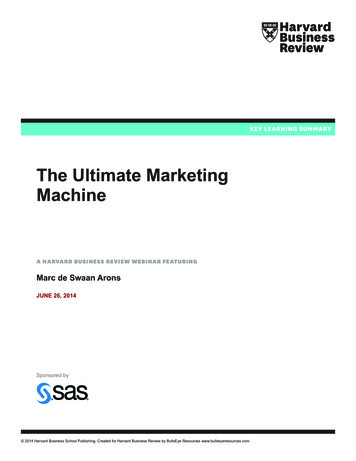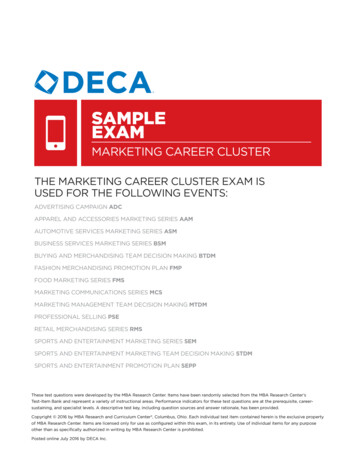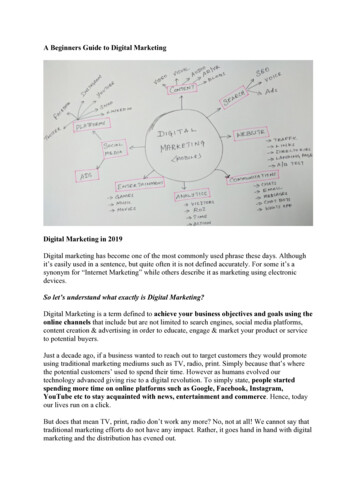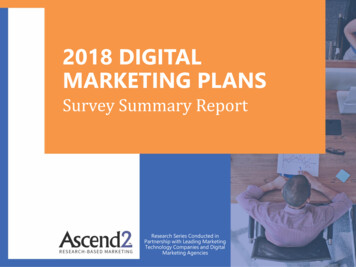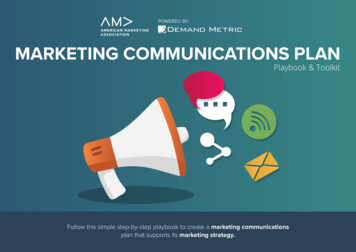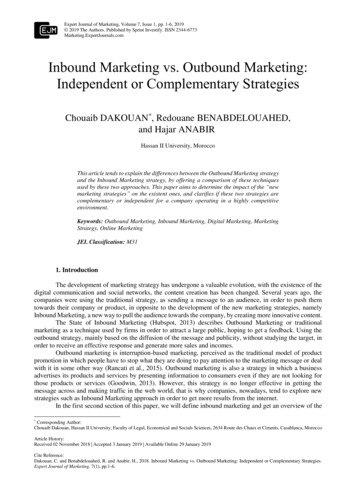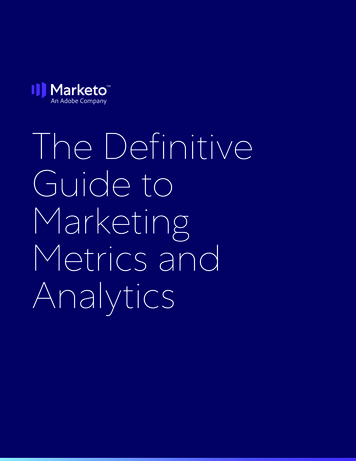
Transcription
The DefinitiveGuide toMarketingMetrics andAnalytics
Table of Contents4PART 1Measurement Builds Respectand Accountability6PART 2Planning for Marketing ROI12PART 3A Framework for Measurement24PART 4Revenue Analytics32PART 5Marketing PerformanceMeasurement45PART 6The Art of Forecasting57PART 7Dashboards62PART 8Implementation: Team, Tactics,TechnologyT H E D E F I N I T I V E G U I D E T O M A R K E T I N G M E T R I C S & A N A LY T I C S2
INTRODUCTIONWhy Should I Read theDefinitive Guide to MarketingMetrics and Analytics?Marketing metrics and analytics—done right—can be astrategic enabler of trust, greater budget, and increasedbusiness impact. Today’s CMO is allocating more timeand budget than ever before to understand marketing’sperformance and influence on growth.Gartner found that marketing analytics42.1% of organizations report usingarea. Gartner found that only one third ofearns the greatest share of marketingmarketing analytics for decision-makingCMOs say ROI of total marketing spendbudget at 9.2%, while a recent CMO(the largest percentage in the lastis a strategic key performance indicator.3Survey from Deloitte and Dukefive years).277% of global B2B marketing decisionUniversity’s Fuqua School of Businessmakers cite their use of data andfound that spending on marketingThe growing imperative for marketers toanalytics to guide marketing decisionsanalytics is forecasted to increase byprove their worth has arrived—but manyas one of their department's top fivenearly 200% in the next three years.firms have ground to make up in thisweaknesses, according to Forrester.41T H I S G U I D E W I L L H E L P YO U A N S W E R K E Y Q U E S T I O N SR E L AT E D T O M A R K E T I N G M E T R I C S A N D A N A LY T I C S L I K E :What are the most importantWhich personnel, procedural,How can I best communicatemarketing metrics for my teamand cultural changes need tomarketing results with myto consider?occur within my organizationexecutive team and board?How can I measure my variousmarketing programs’ impact onso I can implement marketingmeasurement?And many more.revenue and profit?T H E D E F I N I T I V E G U I D E T O M A R K E T I N G M E T R I C S & A N A LY T I C S3
PA R T 1MeasurementBuilds Respectand AccountabilityT H E D E F I N I T I V E G U I D E T O M A R K E T I N G M E T R I C S & A N A LY T I C S4
PA R T 1 : M E A S U R E M E N T B U I L D S R E S P E C T A N D AC C O U N TA B I L I T YMarketing suffers from a crisis of credibility. Often,executives outside the marketing department perceive thatmarketing exists solely to support sales, or that it is an artsand crafts function that throws parties, churns out Tweets,and puts logos on pens. Either way, marketing often doesnot command the respect it deserves.What can marketers do so they are seen as part of a machine thatdrives revenue and profits? How can marketers take more controlover the revenue process, build the respect of their organizationalpeers, and earn a seat at the revenue table?of B2B marketing executives measure the impact of marketing programs on revenue.5U S E M E T R I C S T H AT M AT T E R T O T H E C E O A N D C F OIt’s no secret that CEOs and boardsIn today’s economy, CEOs anddon’t care about the open rate of yourCFOs care about growing revenuelast email campaign or your previousand profits:press release’s view count. How much faster are we growing now How much revenue and profit do youforecast for the next quarter? Why are you confident in the aboveanswers?versus last quarter? Last year? How much profit are we making thisquarter versus last quarter?T H E D E F I N I T I V E G U I D E T O M A R K E T I N G M E T R I C S & A N A LY T I C S5
PA R T 1 : M E A S U R E M E N T B U I L D S R E S P E C T A N D AC C O U N TA B I L I T YMetrics like brand awareness, click-through rates,impressions, organic search rankings, and reach areessential—but only to the extent that they quantifiablyconnect to hard metrics like pipeline, revenue, and profit.Of course, marketers must track and measurethe impact of all key marketing activities, bothhard and soft. However, keep all but the mostcritical metrics within marketing.By speaking the same quantitative languageas the CEOs and CFOs, marketers will bettercommunicate marketing’s value and impactto the executive suite.“Without consensus measures of the valuethey create, CMOs face big credibility gapsand enterprise value creation suffers. MASBresearch found that most organizations failto achieve these growth results becausethey fail to agree on a set of clearly defined,common sense, externally validated standardsfor measuring marketing performance.The linkage between marketing metricsand financial outcomes needs furtherdevelopment.” Deborah Wahl, Vice Chair,Association of National Advertisers.6Withoutconsensusmeasures of thevalue they create,CMOs face bigcredibility gapsand enterprisevalue creationsuffers.T H E D E F I N I T I V E G U I D E T O M A R K E T I N G M E T R I C S & A N A LY T I C S6
PA R T 1 : M E A S U R E M E N T B U I L D S R E S P E C T A N D AC C O U N TA B I L I T YCU T PROGR AMS TO BUILD CREDIBILIT YOne of the most useful things a marketer can to do to build credibility withthe CEO is to offer some thoughtful cuts to marketing programs. Show thatyou are “de-funding” things that either:ABCDidn’t workAren't aligned withAre lower priorityevolving company goalsthan other initiativesThis mindset will demonstrate a strong sense that you are managing a portfolioof investments and willing to make hard choices with company money.T H E D E F I N I T I V E G U I D E T O M A R K E T I N G M E T R I C S & A N A LY T I C S7
PA R T 1 : M E A S U R E M E N T B U I L D S R E S P E C T A N D AC C O U N TA B I L I T YKNOW THEI M PA C T O F E A C HMARKETINGINVESTMENTIf you can’t confidently identify whichparts of your marketing truly deliverfinancial returns, marketing’s impactand influence will continue to belimited across your company. Thiswill not only hurt marketing’s authorityand credibility,but it can alsoprevent your company from makingthe right strategic investments toF O R E C A S T R E S U LT S ,NOT SPENDINGMAKE HARDBUSINESS CASESFOR SPENDINGForecasting is perhaps the mostcritical thing marketers can do toWith its forecast in place, marketingchange the perception that marketingmust then make a hard business caseis a cost center.for the resources it needs to deliverIn the same way that you can’t driverequires knowing what it will take—quickly if you rely only on your rear-money, time, and effort—to acquireview mirror, you can’t be an effectivenew qualified leads and nurture thosemarketer if you only report whatleads until they are ready to talkhas happened in the past. The bestto sales.the results it has promised. Thismarketers forecast the results theyimprove results.expect in the future—and quantifyMarketers who use this type oftheir forecasts regarding leads,rigorous methodology can frame theirSee Part 5 for more on measuring thepipeline, and revenue.budgets in terms of investments, notimpact of various marketing programs.costs, and are better able to justify andWhen you talk about marketingdefend their budgets.spending, other executives think ofcosts and profit loss. When you talkabout future results, they think ofrevenue and growth.Sales and marketing must sit togetherat the revenue table to formulateaccurate forecasts.See Part 6 for more on marketingforecasting.T H E D E F I N I T I V E G U I D E T O M A R K E T I N G M E T R I C S & A N A LY T I C S8
PA R T 1 : M E A S U R E M E N T B U I L D S R E S P E C T A N D AC C O U N TA B I L I T YDavid RaabAUTHOR, WINNING THE MARKETINGM E A S U R E M E N T M A R AT H O N“Marketing has always been agrueling and competitive sport—not unlike running a marathon.With the changes in the buyingprocess, in media and technology,and managing expectations, it’s likerunning a marathon as the groundshifts beneath your feet. Whatwas already difficult is becomingincreasingly difficult. If you’re goingto do it without measurement,it’s like running a marathon, in anearthquake, blindfolded.”T H E D E F I N I T I V E G U I D E T O M A R K E T I N G M E T R I C S & A N A LY T I C S9
PA R T 1 : M E A S U R E M E N T B U I L D S R E S P E C T A N D AC C O U N TA B I L I T YMeasure to ImproveMarketing’s Business ImpactAccording to Lori Wizdo, VP and Principal Analyst, ForresterResearch, “you don't measure to report—you measure to getbetter.”7With this mantra in mind, marketers should think criticallyabout the goals they’re trying to achieve. She recommendsteams align marketing goals to a broad set of businessbenefits that span multiple altitudes—from the enterprisestakeholder to the operational or tactical owner:8T H E D E F I N I T I V E G U I D E T O M A R K E T I N G M E T R I C S & A N A LY T I C S10
PA R T 1 : M E A S U R E M E N T B U I L D S R E S P E C T A N D AC C O U N TA B I L I T YDIFFERENTS TA K E H O L D E R S ,DIFFERENT POV9Once you’ve considered the cascade of goals—from the CEO’s enterprise-wide vantage to the campaign owner’s budgetobjectives—you begin to understand the nuances required to communicate marketing’s business value. This logic can helpyou develop your reporting mechanisms for different recipients:EXECUTIVEVA N TA G EFOCUSBoard of DirectorsEnterpriseOrganizational performance and healthCEOEnterpriseRevenue growth and profitabilityCFOEnterpriseCost and profitability managementSales LeaderDepartmentalPipeline development and bookingsRegional LeaderDepartmentalRegional business performanceFor more on boardroom reporting, see Part 8.Ultimately, the role ofmarketing metrics isto demonstrate howmarketing actions affectrevenue outcomes.T H E D E F I N I T I V E G U I D E T O M A R K E T I N G M E T R I C S & A N A LY T I C S11
T H E D E F I N I T I V E G U I D E T O M A R K E T I N G M E T R I C S & A N A LY T I C S12
PA R T 1 : M E A S U R E M E N T B U I L D S R E S P E C T A N D AC C O U N TA B I L I T YWhy Now Is the Time forMarketing MetricsAccording to the Forbes Marketing Accountability Report,the contribution of marketing to enterprise value in anuncertain and digitally driven economy is very large—inmany cases over 50%.10Also, marketers who invest in measuring and managingperformance create more value, achieving 5% better returnson marketing investments and over 7% higher levels ofgrowth performance.W I T H O U T T H E A B I L I T Y T O C O M M U N I C AT E ,Q U A N T I F Y, A N D M E A S U R E M A R K E T I N G VA L U E ,CMO CREDIBILITY AND GROWTH SUFFERS.97%59%78%Of boards that do not haveCMOs that are under pressureCMOs that feel the inability toCMO representationfrom the CEO to provide thecommunicate, quantify, andvalue of marketing12optimize the value marketing11creates hurts them personallyand professionally.13T H E D E F I N I T I V E G U I D E T O M A R K E T I N G M E T R I C S & A N A LY T I C S13
PA R T 1 : M E A S U R E M E N T B U I L D S R E S P E C T A N D AC C O U N TA B I L I T YWe face an incredible opportunity for marketing to reinventitself as a core part of the company’s growth engine.Enter marketing metrics.CEO ratings of marketing’s performance directly rise and fall withmarketing’s ability to quantify howtheir campaigns and programs delivervalue in line with company revenueobjectives. It is more important thanever for marketing to link the impactof its efforts and financial investmentsto revenue and profit, and establishan actual process for marketing ROIin their companies.In fact, in one Forrester study, 74%of high performers measure ROI,compared to 59% of low performers.14stock photoT H E D E F I N I T I V E G U I D E T O M A R K E T I N G M E T R I C S & A N A LY T I C S14
PA R T 1 : M E A S U R E M E N T B U I L D S R E S P E C T A N D AC C O U N TA B I L I T YStephen YeoEUROPEAN MANAGING DIREC TOR ,PA N A S O N I C“I cannot stress enough theimportance of measurement. Ifyou don’t measure what you’redoing; you cannot show theorganization the benefits of whatyou’re bringing to the table—thepipeline, the leads—you willremain a cost center that makesmouse pads, golfing umbrellas,and does pretty advertisements.”T H E D E F I N I T I V E G U I D E T O M A R K E T I N G M E T R I C S & A N A LY T I C S15
PA R T 1 : M E A S U R E M E N T B U I L D S R E S P E C T A N D AC C O U N TA B I L I T YThe 5 Stages of MarketingAccountability1DENIAL“Marketing is an art, not a science. Itcan’t be measured. The results willcome. Trust me!”2 3FEAR“What if my marketing activities don’timpact the bottom line? Will I loseCONFUSION“I know I should measure marketingresults, but I just don’t know how.”my job?”At first, the CMO may deny the need toTaking on accountability can be scary,The CMO knows that marketingbe accountable for results. Being stuckespecially when you don’t yet knowaccountability is inevitable, but thein this stage often leads to marketing’show well (or poorly) your departmentpath to achieving it remains hidden.isolation from other departmentsis doing. Marketing accountabilityTeams put primary metrics such asand executives.is a double-edged sword, shining alead source tracking and cost-per-leadbright light on weak as well as excel-in place, but there is no holistic under-lent performance. Some CMOs maystanding of how marketing activitiesbe tempted to avoid responsibility byare impacting key bottom-line metrics.not facing which category they fall in.T H E D E F I N I T I V E G U I D E T O M A R K E T I N G M E T R I C S & A N A LY T I C S16
PA R T 1 : M E A S U R E M E N T B U I L D S R E S P E C T A N D AC C O U N TA B I L I T YThe 5 Stages of MarketingAccountability4 5SELF-PROMOTION“Hey, look at all these charts andA C C O U N TA B I L I T Y“Revenue starts with marketing.”graphs!”In an attempt to appear account-At this stage, marketing indeed findsable, marketing measures everythingits place in front of the revenue pipe-that can be (easily) measured—fromline—where marketing stops beingwebsite page views to social follow-a cost center and starts justifyingers to search engine rankings. Thesemarketing expenditures as invest-CMOs proudly display their resultsments in revenue and growth. This isand claim marketing accountability.when the CMO can act and talk like aHowever, important as these metricsC-level executive, measuring and fore-may be, they lack an explicit connec-casting marketing’s impact on metricstion to hard metrics like pipeline, reve-that matter to the CEO and CFO. Thennue, and profit. The result is a focus onmarketing truly earns a seat at thesome marketing KPIs instead of solidrevenue table.revenue growth or short-term ROI overlong-term marketing accountability.Inevitably, this will reinforce theperception that marketing is a costcenter, not a revenue-producing function.Getting to this final stage of marketing accountabilityis difficult for any organization. It requires top-levelcommitment, discipline, and investment in the rightsystems and tools. It means to rethink marketing incentivesand compensation. The journey may not be easy, but theresults—peer respect and impact on profits—are worth it forany marketing team.T H E D E F I N I T I V E G U I D E T O M A R K E T I N G M E T R I C S & A N A LY T I C S17
PA R T 1 : W H AT I S D I G I TA L A DV E R T I S I N G A N D W H Y I S I T I M P O R TA N T ?T H E D E F I N I T I V E G U I D E T O M A R K E T I N G M E T R I C S & A N A LY T I C S18
PA R T 2Planning forMarketing ROIT H E D E F I N I T I V E G U I D E T O M A R K E T I N G M E T R I C S & A N A LY T I C S19
PA R T 2 : P L A N N I N G F O R M A R K E T I N G R O IMany marketers think of marketing ROI as reporting on theoutcome of their programs; often in the form of a set ofreports they have to deliver monthly. However, the bestcompanies recognize that reporting for reporting’s sake isless important than the decisions those reports enable toimprove profits.It makes the difference between backward-lookingmeasurement and decision-focused management.Reporting for reporting’s sakeForrester found that marketing metrics are only as valuable asthe outcomes they improve.“Being data-driven is no longer enough.Firms must transform into insights-drivenbusinesses to remain competitive. Thesebusinesses work differently: They use datafor insights that are always actionable; theycontinuously learn and invest strategically,and they make insights-to-action a teamsport. A key success factor for insights-drivenbusinesses is alignment on the actions andoutcomes that matter most.”T H E D E F I N I T I V E G U I D E T O M A R K E T I N G M E T R I C S & A N A LY T I C S20
PA R T 2 : P L A N N I N G F O R M A R K E T I N G R O I4 K E Y M I S TA K E S1Insights teams are stuck in descriptive2Recipients of reports and dashboards aren't3Teams use metrics in ways that don't4Data and analytics design focuses on tacticsanalytics and aren't advancing.using them to make decisions.connect to actions that drive outcomes.of B2B marketers that measure with the goalof continuously improving their marketingperformance.16and is disconnected from outcomes.15It’s essential to plan your programs with ROI in mind from the outset. When you quantify the outcome you expect from eachmarketing investment, you can then determine exactly how you will measure the program against those goals and positionyourself to achieve them. The fastest-growing companies measure ROI to find not just what works, but what works better.They focus on “improving ROI,” not just “proving ROI.” Only with discipline, planning, and a closed-loop process, you willbe able to improve your marketing ROI.P L A N N I N G F O R M A R K E T I N G R O I I N V O LV E STHREE MAIN ACTIVITIES:1Establishing targets and ROIestimates up-front2Designing programs to bemeasurableT H E D E F I N I T I V E G U I D E T O M A R K E T I N G M E T R I C S & A N A LY T I C S3Focusing on the decisionsthat will improve marketing21
PA R T 2 : P L A N N I N G F O R M A R K E T I N G R O IMarketing ROIManagement Process1Process begins with ROIscenarios early in theBEST ASSUMPTIONSplanning cycle to shapeobjectives, strategies,and tactics.2aROI SCENARIOSMeasurements areprioritized first and thenOBJECTIVESS T R AT E G YTA C T I C A LPLANI M PA C T &CONTRIBUTIONplanned concurrent tocampaign plans, so testsand variations can beincoporated to improveMEASUREMENT PLANT E S T VA R I AT I O N S I N P L A Nprecision.2bMeasurementsMEASUREMENTScapture lift, diagnoseweaknesses, andgenerate insight toimprove effectiveness.3ROI results guidechanges to strategiesROI MEASUREMENTand tactics in the nextcycle of marketing,based on which have thehigher ROI potential.HISTORY TO GUIDEN E X T C A M PA I G NT H E D E F I N I T I V E G U I D E T O M A R K E T I N G M E T R I C S & A N A LY T I C S22
PA R T 2 : P L A N N I N G F O R M A R K E T I N G R O IE S TA B L I S H R O IGOALS UPFRONTBENEFITS OFROI GOALSYour first step is to quantify yourWith ROI goals in place, the CFO willexpected outcomes. All too often,see not only the cost that goes out themarketers plan programs and commitdoor but also exactly what benefit istheir budgets without establishing aexpected to come from that cost. Asrobust set of expectations about whata result, he will be much more likely toimpact they expect the program tosupport the investment.have. This is a terrible habit and is oneof the underlying reasons why otherWhile rich data will support yourexecutives, especially CFOs, questiongoals and make your argument moremarketing investments.compelling, don’t worry too muchabout the fact that you are makingThe solution is to assign up-frontestimates. As long as they are clearlygoals, benchmarks, and KPIs for eachlabeled, the CFO will understandmarketing program.that any plan requires numerousassumptions. Just the fact that theThe first step of any program planmarketer is walking in the door with ashould be to define your objectivesspreadsheet of numbe
last email campaign or your previous press release’s view count. Marketing suffers from a crisis of credibility. Often, executives outside the marketing department perceive that marketing exists solely to support sales, or that it is an a

